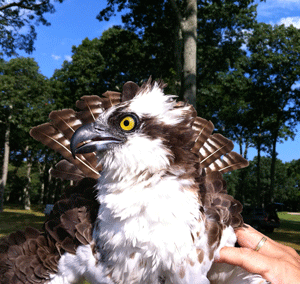On Long Island, in the town of Mattituck overlooking Peconic Bay, I changed my mind and deployed our new PTT on an adult male. We were set up to trap a juvenile, but when we got Dad before Junior, I decided that increasing our sample size of adult males for our studies of home range size from 8 to 9 was more productive than increasing our sample size of juveniles from 31 to 32.
North Fork Bob -- (Bio)
North Fork Bob -
Mattituck, Long Island - 1 Aug 2010
| I
was up the ladder just before 6 AM at a nest
only a few meters from the 5th hole at the North
Fork Golf Club. We had the noose carpet set by
06:10 and the adult female in hand a
record-breaking 7 minutes later! I didn't want
to tag her, so I went up and extracted her from
the carpet, leaving the carpet in place. We
banded her, took some measurements (she weighed
1.64 kg = 3.6 lbs), and let her go. For the next hour and a half, the lone young at this nest was mostly perched near the nest, but didn't show a real interest in landing on the nest, where I had laid out a fancy Mediterranean bronzini (European seabass) beneath the noose carpet. The evening before we went to a high-end fish market rather than a bait shop to get our trapping fish. |
 |
At 08:10 a
male landed on the nest and was caught immediately. He wasn't struggling, so we
let him stand there for a while, hoping the youngster would fly to the nest to
be fed by Dad. Junior just begged loudly from a near-by perch and didn't seem to
want to go to the nest, so I went up and got the male out of the noose carpet.
I then made a spur-of-the-moment decision to tag this
bird. With memories of the 11-hour marathon wait to catch the youngster down in
Delaware fresh in my mind, I decided to tag the bird-in-hand, adding another
male to our study of home range size and foraging ecology rather than waiting to
catch the young. Tagging the male increased our sample size for adult males from
8 to 9, which was a more significant return on the investment than increasing
our sample for youngsters from 31 to 32.
We came back to check on them around 11:00. Mom and the
young were on the nest enjoying the bronzini, which was a big one and would keep
them happy for the rest of the afternoon.
When I downloaded the first data for this bird, a
nagging suspicion was confirmed. It seems North Fork Bob should have been named
"Light-taloned Louie." Just before we caught the male at the nest, others in our
group noticed a male flying over the nest with fish in its talons. The bird we
saw land in the nest and then caught didn't have anything in its feet. It's
unusual for a male to land in its nest without food. I didn't think of this at
the time, but later, as I reran the whole process in my mind, I wondered if we
hadn't caught one of the neighbors who couldn't pass up the chance for a
freebie. He must have thought that if no one else wanted that fish, he'd be
happy to take it.
Since we trapped him early on the 1st, he hasn't been
even near our target nest, but is hanging out about a mile west. Lots of points
at one spot, so I think this bird belongs to the neighboring nest.
Wildlife biology in never short of surprises.
See
more pictures of trapping Bob.